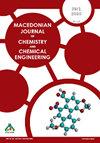Synthesis and characterization of silver nanoparticles using Sphaerophysa kotschyana fruit and the assessment of their antioxidant activity
IF 0.6
4区 化学
Q3 CHEMISTRY, MULTIDISCIPLINARY
Macedonian Journal of Chemistry and Chemical Engineering
Pub Date : 2022-12-31
DOI:10.20450/mjcce.2022.2579
引用次数: 0
Abstract
Nanoparticles have attracted great interest recently due to their application in many fields. In this study, an eco-friendly, scalable, cost-effective method was used for the synthesis of silver nanoparticles (s-AgNPs) using the fruit extract of Sphaerophysa kotschyana as a reducing agent, and their structure was elucidated by extensive spectroscopic techniques. The color change from yellow to dark brown indicated the formation of s-AgNPs. In the UV-Vis spectrum, the maximum absorption was observed at 437 nm. Fourier transform infrared (FTIR) spectroscopy displayed the functional group of the natural compounds in the extract that capped and stabilized the s-AgNPs. The characteristic hydroxyl vibrational signal appeared at 3168 cm–1. The X-ray diffraction (XRD) pattern indicated that the s-AgNPs were face-centered cubic crystalline structures. Scanning electron microscopy (SEM) exhibited the spherical-shaped nanoparticles with an average size of 67.37 nm. The antioxidant activity of the extract and s-AgNPs was established using the DPPH, ABTS, and FRAP assays. In the DPPH test, the effect of s-AgNPs was observed to be significantly higher than that of the extract, and the activity of s-AgNPs in the FRAP test was also reported to be higher than the extract. In the ABTS assay, the s-AgNPs displayed outstanding activity, which was even better than the standards. Consequently, s-AgNPs synthesized from S. kotschyana are promising drug products for diseases caused by oxidative stress.利用大叶藻果实制备纳米银及其抗氧化活性评价
纳米粒子由于其在许多领域的应用而引起了人们的极大兴趣。在本研究中,采用一种生态友好、可扩展、成本效益高的方法,以小黄藻果实提取物为还原剂合成银纳米颗粒(s-AgNPs),并通过广泛的光谱技术阐明了其结构。从黄色到深棕色的颜色变化表明s-AgNPs的形成。在UV-Vis光谱中,在437nm处观察到最大吸收。傅立叶变换红外光谱(FTIR)显示了提取物中天然化合物的官能团,该官能团覆盖并稳定了s-AgNP。特征羟基振动信号出现在3168 cm–1处。X射线衍射(XRD)图谱表明,s-AgNPs为面心立方晶体结构。扫描电子显微镜(SEM)显示出平均尺寸为67.37nm的球形纳米颗粒。使用DPPH、ABTS和FRAP测定法确定提取物和s-AgNPs的抗氧化活性。在DPPH测试中,观察到s-AgNPs的作用显著高于提取物,并且据报道,在FRAP测试中s-AgNPs的活性也高于提取物。在ABTS测定中,s-AgNPs表现出突出的活性,甚至优于标准。因此,从s.kotschyana合成的s-AgNPs是治疗氧化应激引起的疾病的有前景的药物产品。
本文章由计算机程序翻译,如有差异,请以英文原文为准。
求助全文
约1分钟内获得全文
求助全文
来源期刊
CiteScore
1.60
自引率
20.00%
发文量
14
审稿时长
>12 weeks
期刊介绍:
Macedonian Journal of Chemistry and Chemical Engineering (Maced. J. Chem. Chem. Eng.) is an official publication of the Society of Chemists and Technologists of Macedonia. It is a not-for-profit open acess journal published twice a year. The journal publishes original scientific papers, short communications, reviews and educational papers from all fields of chemistry, chemical engineering, food technology, biotechnology and material sciences, metallurgy and related fields. The papers published in the Journal are summarized in Chemical Abstracts.

 求助内容:
求助内容: 应助结果提醒方式:
应助结果提醒方式:


